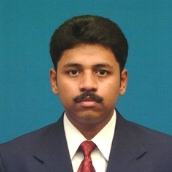International Journal of Intelligent Systems and Applications (IJISA)
IJISA Vol. 10, No. 10, 8 Oct. 2018
Cover page and Table of Contents: PDF (size: 1654KB)
Power Quality Improvement for Wind Energy Conversion System using Composite Observer Controller with Fuzzy Logic
Full Text (PDF, 1654KB), PP.72-80
Views: 0 Downloads: 0
Author(s)
Index Terms
Distributed static compensator (DSTATCOM), fuzzy logic controller, induction generator, nonlinear load, power quality, voltage control, voltage source controller (VSC)
Abstract
In this paper, power quality at the distribution system has been examined by introducing an observer based control technique with fuzzy logic controller for wind energy conversion systems with constant wind velocity, for combination of linear, nonlinear loads and with load removal in one of the phases. The power quality improvement, including voltage regulation and reactive power management on the distribution side is achieved and the device used here is a distributed static compensator (DSTATCOM) a voltage source converter(VSC) based power electronic device. The performance is found to be satisfactory with the implementation of DSTATCOM for better voltage regulation with self-sustained DC link voltage at VSC of DSTATCOM. The fuzzy logic controller is used to generate gate pulses to VSC for power quality improvement and is simulated in MATLAB environment and results are studied.
Cite This Paper
Hemanth Kumar. M.B, Saravanan. B, "Power Quality Improvement for Wind Energy Conversion System using Composite Observer Controller with Fuzzy Logic", International Journal of Intelligent Systems and Applications(IJISA), Vol.10, No.10, pp.72-80, 2018. DOI:10.5815/ijisa.2018.10.08
Reference
[1]D. M. Tagare, Electric Power Generation: The Changing Dimensions.Hoboken, NJ, USA: Wiley, 2011.
[2]C. Bhattacharjee and B. K. Roy, “Advanced fuzzy power extraction control of wind energy conversion system for power quality improvement in a grid tied hybrid generation system,” IET Gener. Transm. Distrib., vol. 10, no. 5, pp. 1179–1189, 2016.
[3]Y. Fan, G. Hu, and M. Egerstedt, “Distributed Reactive Power Sharing Control for Microgrids with Event-Triggered Communication,” IEEE Trans. Control Syst. Technol., vol. 25, no. 1, pp. 118–128, 2017.
[4]L. Wang, C. H. Chang, B. L. Kuan, and A. V. Prokhorov, “Stability Improvement of a Two-Area Power System Connected with an Integrated Onshore and Offshore Wind Farm Using a STATCOM,” IEEE Trans. Ind. Appl., vol. 53, no. 2, pp. 867–877, 2017.
[5]A.Kulmala, S. Repo, and P. Jarventausta, “Coordinated voltage controlin distribution networks including several distributed energy resources,”IEEE Trans. Smart Grid, vol. 5, no. 4, pp. 2010–2020,Jul. 2014.
[6]T. Bogodorova, S. Member, L. Vanfretti, and S. Member, “Model Structure Choice for a Static VAR Compensator under Modeling Uncertainty and Incomplete Information,” vol. 3536, no. c, pp. 1–9, 2017.
[7]S. Gao, G. Bhuvaneswari, S. S. Murthy, and U. Kalla, “Efficient voltage regulation scheme for three-phase self-excited induction generator feeding single-phase load in remote locations,” IET Renew. Power Gener., vol. 8, no. 2, pp. 100–108, Mar. 2014.
[8]B. Singh, S. Jain, S. Gupta, and S. Tiwari, “Series active filter based voltage controller for an isolated asynchronous generator,” in Proc. IEEE Int. Conf. Power Electron., Drives Energy Syst., 2012, pp. 1–6.
[9]S. S. Murthy and R. K. Ahuja, “Design and analysis of three phase selfexcited induction generator usingMATLAB graphical user interface based methodology,” in Proc. Int. Conf. Power, Control Embedded Syst., 2010, pp. 1–5.
[10]L. Kalamen, P. Rafajdus, P. Sekerak, and V. Hrabovcova, “A novelmethod of magnetizing inductance investigation of self-excited induction generators,” IEEE Trans. Magn., vol. 48, no. 4, pp. 1657–1660, Apr. 2012.
[11]J. M. Ramirez and M. Emmanuel Torres, “An electronic load controller for the self-excited induction generator,” IEEE Trans. Energy Convers., vol. 22, no. 2, pp. 546–548, Jun. 2007.
[12]G. Cimuca, S. Breban, M. M. Radulescu, C. Saudemont, and B. Robyns, “Design and control strategies of an induction-machinebasedflywheel energy storage system associated to a variable-speed wind generator,” IEEE Trans. Energy Convers., vol. 25, no. 2, pp. 526–534, Jun. 2010.
[13]R. Mitra, A. K. Goswami, and P. K. Tiwari, “Voltage sag assessment using type-2 fuzzy system considering uncertainties in distribution system,” IET Gener. Transm. Distrib., vol. 11, no. 6, pp. 1409–1419, 2017.
[14]A. C. Moreira, H. K. M. Paredes, W. A. de Souza, F. P. Marafao, and L. C. P. da Silva, “Intelligent Expert System for Power Quality Improvement Under Distorted and Unbalanced Conditions in Three-Phase AC Microgrids,” IEEE Trans. Smart Grid, vol. 3053, no. c, pp. 1–1, 2017.
[15]B.Singh, S. S. Murthy, and S. Gupta, “Analysis and design of STATCOMbased voltage regulator for self-excited induction generators,” IEEE Trans.Energy Convers., vol. 19, no. 4, pp. 783–790, Dec. 2004.
[16]B.Singh, S. S. Murthy, and S. Gupta, “STATCOM-based voltage regulator for self-excited induction generator feeding nonlinear loads,” IEEE Trans. Ind. Electron., vol. 53, no. 5, pp. 1437–1452, Oct. 2006.
[17]R. Karthigaivel, N. Kumaresan, and M. Subbiah, “Analysis and control of self-excited induction generator-converter systems for battery chargingapplications,” intellect.PowerAppl., vol. 5, no. 2, pp. 247–257, Feb. 2011.
[18]J. A. Barrado, R. Grino, and H. Valderrama-Blavi, “Power-quality improvement of a stand-alone induction generator using a STATCOM With battery energy storage system,” IEEE Trans. Power Del., vol. 25, no. 4, pp. 2734–2741, Oct. 2010.
[19]W.-L. Chen, Y.-H. Lin, H.-S. Gau, and C.-H. Yu, “STATCOM controls for a self-excited induction generator feeding random loads,” IEEE Trans. Power Del., vol. 23, no. 4, pp. 2207–2215, Oct. 2008.
[20]Ganesh C, Anupama S, Kumar MBH. Control of Wind Energy Conversion System and Power Quality Improvement in the Sub Rated Region Using Extremum Seeking. Indonesian Journal of Electrical Engineering and Informatics. 2016; 4(1): 14-23.
[21]A.Ghaffari, M. Krstić and S. Seshagiri, "Power Optimization and Control in Wind Energy Conversion Systems Using Extremum Seeking," in IEEE Transactions on Control Systems Technology, vol. 22, no. 5, pp. 1684-1695, Sept. 2014.
[22]X. Chen, X. Ruan, D. Yang, W. Zhao, and L. Jia, “Injected Grid Current Quality Improvement for Voltage-Controlled Grid-Connected Inverter,” IEEE Trans. Power Electron., vol. 33, no. 2, pp. 1–1, 2017.
[23]M. Badoni, A. Singh, and B. Singh, “Adaptive Neurofuzzy Inference System Least-Mean-Square-Based Control Algorithm for DSTATCOM,” IEEE Trans. Ind. Informatics, vol. 12, no. 2, pp. 483–492, 2016.
[24]Belaidi R Haddouche A guendouz H Fuzzy logic controller based three phase power filter for compensating harmonics and reactive power under unbalanced main voltages. Energy procedia,2012;vol.18,p.560-570.
[25]Karuppanan P ,Kamala Kanta Mahapatra, PI with fuzzy logic controller based APLC for compensating harmonicand reactive power. Proceeding Conference on control. Communication and power engineering 2010,p.45-49
[26]A. C. Moreira, H. K. M. Paredes, W. A. de Souza, F. P. Marafao, and L. C. P. da Silva, “Intelligent Expert System for Power Quality Improvement Under Distorted and Unbalanced Conditions in Three-Phase AC Microgrids,” IEEE Trans. Smart Grid, vol. 3053, no. c, pp. 1–1, 2017.
[27]P. Chittora, A. Singh, and M. Singh, “Performance evaluation of digital filters in distribution static compensator for non-linear loads,” IET Power Electron., vol. 10, no. 14, pp. 1915–1923, 2017.
[28]Ramji Tiwari, Ramesh Babu. N, "Comparative Analysis of Pitch Angle Controller Strategies for PMSG Based Wind Energy Conversion System", International Journal of Intelligent Systems and Applications(IJISA), Vol.9, No.5, pp.62-73, 2017. DOI: 10.5815/ijisa.2017.05.08
[29]Kuldeep Singh,"Fuzzy Logic Based Modified Adaptive Modulation Implementation for Performance Enhancement in OFDM Systems", International Journal of Intelligent Systems and Applications(IJISA), Vol.8, No.5, pp.49-54, 2016. DOI: 10.5815/ijisa.2016.05.07
[30]Hadi Sefidgar, S. Asghar Gholamian,"Fuzzy Logic Control of Wind Turbine System Connection to PM Synchronous Generator for Maximum Power Point Tracking", IJISA, vol.6, no.7, pp.29-35, 2014. DOI: 10.5815/ijisa.2014.07.04
[31]Hamid Reza Erfanian, Mohammad Javad Abdi, Sahar Kahrizi,"Solving a Linear Programming with Fuzzy Constraint and Objective Coefficients", International Journal of Intelligent Systems and Applications(IJISA), Vol.8, No.7, pp.65-72, 2016. DOI: 10.5815/ijisa.2016.07.07
[32]Nidhi Arora, Jatinderkumar R. Saini,"Estimation and Approximation Using Neuro-Fuzzy Systems", International Journal of Intelligent Systems and Applications(IJISA), Vol.8, No.6, pp.9-18, 2016. DOI: 10.5815/ijisa.2016.06.02
[33]Mekalathur, Hemanth Kumar B. "An improved Resonant Fault Current Limiter for Distribution System under Transient Conditions." International Journal of Renewable Energy Research (IJRER) 7.2 (2017): 547-555

